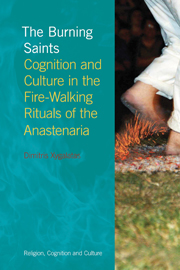Book contents
- Frontmatter
- Dedication
- Contents
- List of illustrations
- Acknowledgements
- 1 Introduction
- 2 Tradition in the making
- 3 The ethnographic setting
- 4 Fire-walking in Agia Eleni
- 5 Knowledge and revelation among the Anastenaria
- 6 Ritual and mind
- 7 Costly rituals
- 8 Arousal, emotion and motivation
- 9 The physiology of high-arousal rituals
- 10 Putting it all together
- Notes
- Bibliography
- Index
9 - The physiology of high-arousal rituals
- Frontmatter
- Dedication
- Contents
- List of illustrations
- Acknowledgements
- 1 Introduction
- 2 Tradition in the making
- 3 The ethnographic setting
- 4 Fire-walking in Agia Eleni
- 5 Knowledge and revelation among the Anastenaria
- 6 Ritual and mind
- 7 Costly rituals
- 8 Arousal, emotion and motivation
- 9 The physiology of high-arousal rituals
- 10 Putting it all together
- Notes
- Bibliography
- Index
Summary
As we have seen, the role of arousal in the transmission of rituals has already been emphasized. Harvey Whitehouse has claimed that emotional arousal is one of the two critical factors that determine a particular ritual's success (1995, 2000, 2002a, 2004; also see chapter 6). Lawson and McCauley have also recognized the role of arousal, referring to emotionally provocative sensory arousal, or “sensory pageantry” as they call it (1990; McCauley and Lawson 2002). Both Whitehouse and Lawson and McCauley also agree that arousal can have significant implications for the motivation of participants to maintain and transmit those rituals. This chapter will attempt to shed some light on this connection between arousal and motivation.
Arousal and consciousness
High-arousal rituals have by virtue of their form certain properties that often allow them to induce exceptional feelings, sensations and perceptions in their performers. The relation between the practice of stressful and strenuous ritual activities and altered states of consciousness has long been noted (e.g. Ludwig 1968). It seems that certain rituals may alter consciousness by eliciting the appropriate responses of the brain. Stress, physical exhaustion, sensory overload, repetitive music, dancing, fasting, the use of psychoactive drugs, all are some of the components of high-arousal rituals around the world that can have profound effects on consciousness.
- Type
- Chapter
- Information
- The Burning SaintsCognition and Culture in the Fire-Walking Rituals of the Anastenaria, pp. 167 - 184Publisher: Acumen PublishingPrint publication year: 2012



